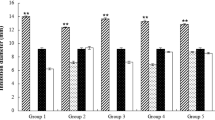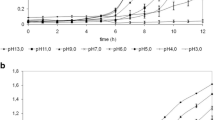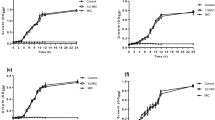Abstract
Lactobacillus plantarum is one of common probiotics in fermented foods. Quorum sensing (QS) is a common communication way within bacteria. It is not clear whether the probiotic properties of L. plantarum mediated by QS. Here, Lb. plantarum YM-4–3 was examined for resistance of pH, bile, antimicrobial and luxS gene expression pattern. The study found that: (1) the supernatant of YM-4–3 had bacteriostatic effect to Escherichia coli O157:H7, Listeria monocytogenes and Staphylococcus aureus; (2) Lb. plantarum YM-4–3 shown tolerance property to the strongest acid culture that pH value of 3; (3) the bile tolerance of Lb. plantarum YM-4–3 was significant difference with the growth stage, the early exponential phase of the growth culture can tolerate bile of 0.4% (w/v), while the stationary growth stage can only tolerate bile of 0.2%; (4) Lb. plantarum YM-4–3 luxS gene was contrary expression along with the growth. (5) Compared with the wild-type strain, the adhesion ability of Lb. plantarum YM-4–3 ΔluxS was decreased obviously. These results showed that AI-2 LuxS quorum sensing system mediating Lb. plantarum acid, bile tolerance, antimicrobial and adhesion of probiotics.





Similar content being viewed by others
References
Buck BL, Azcarate-Peril MA, Klaenhammer TR (2009) Role of autoinducer-2 on the adhesion ability of Lactobacillus acidophilus. J Appl Microbiol 107:269–279
Chen X, Schauder S, Potier N, Van Dorsselaer A, Pelczer I, Bassler BL et al (2002) Structural identification of a bacterial quorum sensing signal containing boron. Nature 415:545–549
Chou LS, Weimer B (1999) Isolation and characterization of acid and bile tolerant isolates from strains of Lactobacillus acidophilus. J Dairy Sci 82:23–31
Coconnier MH, Klaenhammer TR, Kernéis S, Bernet MF, Servin AL (1992) Protein-mediated adhesion of Lactobacillus acidophilus BG2FO4 on human enterocyte and mucus-secreting cell lines in culture. Appl Environ Microbiol 58:2034–2039
Collado MC, Gueimonde M, Hernandez M, Sanz Y, Salminen S (2005) Adhesion of selected Bifidobacterium strains to human intestinal mucus and its role in enteropathogen exclusion. J Food Protect 68:2672–2678
Collins JK, Thornton G, Sullivan GO (1998) Selection of probiotic strains for human applications. Int Dairy J 8:487–490
Darfeuille-Michaud A, Aubel D, Chauviere G, Rich C, Bourges M, Servin A et al (1990) Adhesion of enterotoxi-genic Escherichia coli to the human colon carcinoma cell line Caco-2 in culture. Infect Immun 58:893–902
De Keersmaecker SC, Sonck K, Vanderleyden J (2006) Let LuxS speak up in AI-2 signaling. Trends Microbiol 14:114–119
Deng Y, Wu J, Tao F, Zhang LH (2011) Listening to a new language: DSF-based quorum sensing in gram-negative bacteria. Chem Rev 111:160–173
FAO, WHO (2001) Evaluation of health and nutritional properties of probiotics in food including powder milk with live lactic acid bacteria. Merian Córdoba Park Hotel, Córdoba, Argentina
Finlay BB, Falkow S (1989) Common themes in microbial pathogenicity revisited. Microbiol Mol Biol R 53:210–230
Jia FF, Pang XH, Zhu DQ, Zhu ZT, Sun SR, Meng XC (2017) Role of the luxs gene in bacteriocin biosynthesis by Lactobacillus plantarum klds1.0391: a proteomic analysis. Sci Rep 7(1):13871
Kerneis S, Bilge SS, Fourel V, Chauviere G, Coconnier MH, Servin AL (1991) Use of purified F1845 fimbrial adhesin to study localization and expression of receptors for diffusely adhering Escherichia coli (DAEC) during enterocytic differentiation of human colon carcinoma cell lines HT-29 and Caco-2 in culture. Infect Immun 59:4013–4018
Kernéis S, Chauvière G, Darfeuille-Michaud A, Aubel D, Coconnier MH, Joly B et al (1992) Expression of receptors of enterotoxigenic Escherichia coli during enterocytic differentiation of human intestinal epithelial cells, Caco-2 and HT-29 in culture. Infect Immun 60:2572–2580
Lankaputhra WE, Shah NP, Britz ML (1996) Survival of Bifidobacteria during refrigerated storage in the presence of acid and hydrogen peroxide. Milchwissenschaft 51:65–69
Lebeer S, Claes IJ, Verhoeven TL, Shen C, Lambrichts I, Ceuppens JL (2008) Impact of luxS and suppressor mutations on the gastrointestinal transit of Lactobacillus rhamnosus GG. Appl Environ Microbiol 74:4711–4718
Lei L, Ruiyun W, Jinlan Z, Nan S, Pinglan L (2017) D-ribose interferes with quorum sensing to inhibit biofilm formation of Lactobacillus paraplantarum l-zs9. Front Microbiol 8:1860
Moslehi-Jenabian S, Gori K, Jespersen L (2009) AI-2 signaling is induced by acidic shock in probiotic strains of Lactobacillus spp. Int J Food Microbiol 135:295–302
Moslehi-Jenabian S, Vogensen FK, Jespersen L (2011) The quorum sensing luxS gene is induced in Lactobacillus acidophilus NCFM in response to Listeria monocytogenes. Int J Food Microbiol 149:269–273
Mounier J, Vasselon T, Hellio R, Lesourd M, Sansonetti PJ (1992) Shigella flexnerienters human colonic Caco-2 epithelial cell through the basolateral pole. Infect Immun 60:237–248
Ouwehand AC, Isolauri E, Kirjavainen PV, Salminen SJ (1999) Adhesion of four Bifidobacterium strains to human intestinal mucus from subjects in different age groups. FEMS Microbiol Lett 172:61–64
Pan X, Chen F, Wu T, Tang H, Zhao Z (2009) The acid, bile tolerance and antimicrobial property of Lactobacillus acidophilus nit. Food Control 20:598–602
Park H, Shin H, Lee K, Holzapfel W (2016) Autoinducer-2 properties of kimchi are associated with lactic acid bacteria involved in its fermentation. Int J Food Microbiol 225:38–42
Pereira DI, Gibson GR (2002) Cholesterol assimilation by lactic acid bacteria and Bifidobacteria isolated from the human gut. Appl Environ Microbiol 68:4689–4693
Pinto M, Robine-Leon S, Appay MD, Kedinger M, Triadou N, Dussaulx E (1983) Enterocyte-like differentiation and polarization of the human coloncarcinoma cell line Caco-2 in culture. Mol Biol Cell 47:323–330
Ramos AN, Cabral ME, Noseda D, Bosch A, Yantorno OM, Valdez JC (2012) Antipathogenic properties of Lactobacillus plantarum on Pseudomonas aeruginosa: the potentialuse of its supernatants in the treatment of infected chronic wounds. Wound Repair Regen 20:552–562
Rizzello CG, Filannino P, Di Cagno R, Calasso M, Gobbetti M (2014) Quorum-sensing regulation of constitutive plantaricin by Lactobacillus plantarum strains under a model system for vegetables and fruits. Appl Environ Microbiol 80:777–787
Shah NP, Lankaputhra WEV, Britz ML, Kyle WSA (1995) Survival of Lactobacillus acidophilus and Bifidobacterium bifidum in commercial yoghurt during refrigerated storage. Int Dairy J 5:2–7
Song XD, Liu CJ, Huang SH, Li XR, Yang E, Luo YY (2018) Cloning, expression and characterization of two S-ribosylhomocysteine lyases from Lactobacillus plantarum YM-4-3: implication of conserved and divergent roles in quorum sensing. Protein Expres Purif 145:32–38
Vernazza CL, Gibson GR, Rastall RA (2006) Carbohydrate preference, acid tolerance and bile tolerance in five strains of Bifidobacterium. J Appl Microbiol 100:846–853
Acknowledgements
This work was supported by the Young Academic and Technical Leader Raising Foundation of Yunnan province (to Yiyong Luo), the Ten-thousand Talents Program in Yunnan province (to Yiyong Luo). Sponsored by K.C. Wong Magna Fund at Ningbo University and General project of Zhejiang Department of Education (Y202043742). This work was supported by National Natural Science Foundation of China (Grant nos. 31300068 and 31660451).
Author information
Authors and Affiliations
Corresponding author
Ethics declarations
Conflicts of interest
The authors declare no conflict of interest.
Ethics statement
Ethical approval was obtained from the Institutional Ethics Committee (Kunming University of science and technology, Kunming, Yunnan, China). The study protocol was in accordance with the Declaration of Helsinki for Human Research of 1974 (last modified in 2000).
Additional information
Communicated by Erko Stackebrandt.
Publisher's Note
Springer Nature remains neutral with regard to jurisdictional claims in published maps and institutional affiliations.
Rights and permissions
About this article
Cite this article
Jiang, L., Luo, Y., Cao, X. et al. LuxS quorum sensing system mediating Lactobacillus plantarum probiotic characteristics. Arch Microbiol 203, 4141–4148 (2021). https://doi.org/10.1007/s00203-021-02404-5
Received:
Revised:
Accepted:
Published:
Issue Date:
DOI: https://doi.org/10.1007/s00203-021-02404-5




